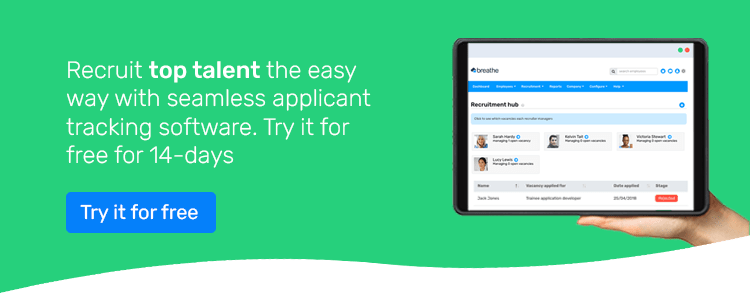Everyone has an equal right to employment – but disabled people are still under-represented in the UK workforce.
With disability employment levels only just returning to pre-pandemic levels (according to a Labour Force survey) it can be difficult to know where to start in providing equal access to job opportunities.
Here we cover what SME’s might want to consider when recruiting people with disabilities, how hiring processes can be made more accessible, and how hiring people with disabilities benefits organisations.
Creating inclusive workplaces
With more and more organisations looking at how they can be more inclusive and diverse, an important part of that is evaluating disability hiring practices.
It’s therefore important to consider your hiring process and to make sure you receive applications from a wide range of applicants. You don’t want to inadvertently discourage strong applicants simply because they feel the job isn’t truly open or accessible to them.
What is a disability?
Under the Equality Act 2010, disability is defined as “a physical or mental impairment that has a substantial and long-term negative effect on your ability to do normal daily activities.”
A misconception still exists that disabled people are mainly (or only) wheelchair users. Disabilities or impairments can cover a wide range of issues, both mental and physical. Some are visible, but others aren’t. Read more about the definition of disability in our blog on disability discrimination.
How to improve your disability recruitment process
Consider the language you use in your job specification. Could you be unintentionally excluding applicants or putting worthy candidates off before they finish reading the job description?
In this section, we suggest a few things SMEs might want to consider when thinking about improving recruitment processes, with disabled people in mind.
Writing job descriptions with disability in mind
Legally, disabled applicants must not be excluded from applying for a job where the job specification unfairly disadvantages disabled people for no relevant reason – this could be classed as discrimination.
For example, if an advertised job was for a taxi-driving position, it would be reasonable and necessary to state that applicants would need to hold a valid driving license.
However, if driving wasn’t essential to the role and travel could be achieved via public transport, but the job specification still listed a driving license as a requirement, this could be classed as disability discrimination.
Consider the language you’re using when creating a job description, especially when it comes to requirements of the role. Think about what is necessary to the job, and whether your specification is accessible to a disabled person – or whether you could make any reasonable adjustments.
Reasonable adjustments to the recruitment process
What is a reasonable adjustment?
Employers are required by law to make reasonable adjustments to the recruitment process or to make employment more accessible for disabled people.
ACAS defines reasonable adjustments as:
“a change that must be made to remove or reduce a disadvantage related to an employee's disability when doing their job, and/or a job applicant's disability when applying for a job.”
Reasonable adjustments can cover the physical work environment, ensuring information is accessible and also the equipment employees use for work.
An example of a reasonable adjustment when someone is applying for a job would be offering any documentation with the option of large print, or braille. Someone who requires the use of a screen reader should be permitted to use this rather than filling out forms with a pen, for example.
These adjustments can be reasonably accommodated by a potential employer to assist a disabled person in a more equal opportunity.
Accessible information
Make it clear what reasonable adjustments are available as early as possible at application stage. This is important to avoid excluding anyone or (however unintentionally) dissuading anyone from applying for the job.
It also means that people with disabilities don’t have to ask for additional support or access, as this has been made clear from the start.
Physical environment and equipment
Employers and potential employers should also consider how accessible their office buildings or places of work are. If a disabled person was attending an interview at your workplace, consider whether you offer step-free access to your building, or floors of your offices? Are your toilet facilities accessible to someone who uses a wheelchair or a walking aid?
Perhaps your applicant has disabilities that mean they require or would prefer to bring along a representative to their interview. Rather than filling out a lengthy questionnaire with pen, perhaps the applicant finds it easier to type on a keyboard.
Be prepared to adapt the way you run interviews and the way things have been done within your organisation.
The benefits of hiring disabled people
It’s always valuable to hire people with a wide range of abilities and talents – this benefits any organisation.
Disabled people are more committed to their roles and tend to stay with an employer longer than non-disabled people. “Disabled candidates…perform as effectively, if not better, than their colleagues according to BT (via Remploy).
In a quote via Remploy, ASDA state that “the commitment [of disabled people] to the job is absolutely massive.”
Disabled people are a huge asset to any business – and often have valuable skillsets and levels of motivation that non-disabled people don’t have.
Prioritising access for everyone
It can be difficult to know where to start in creating a more equal and inclusive workplace.
Whether you work in HR, recruitment, or management – start by offering disability awareness training. Try to shift the focus from the disabled person having something that impairs them to something that is no different to many invisible impairments that so many people deal with every day.
Investing in accessible software and working on improving your cultural attitude to disability are good ways to start breaking down the social barriers that disabled people face daily.
Widening the scope of job descriptions will help to allow disabled people to feel included, welcomed and very much an asset to a business. Considering your physical office environment and challenging ‘the way things are done around here’ is a good place to begin.
You can safely store your disability awareness training records and your accessible job descriptions for disability-friendly hiring procedures within Breathe.

Author: Aimée Brougham-Chandler
An IDM-certified Digital Copywriter as of February 2023, Aimée is Breathe's Content Assistant. With a passion for guiding readers to solutions for their HR woes, she enjoys delving into & demystifying all things HR: From employee performance to health and wellbeing, leave to company culture & much more.




